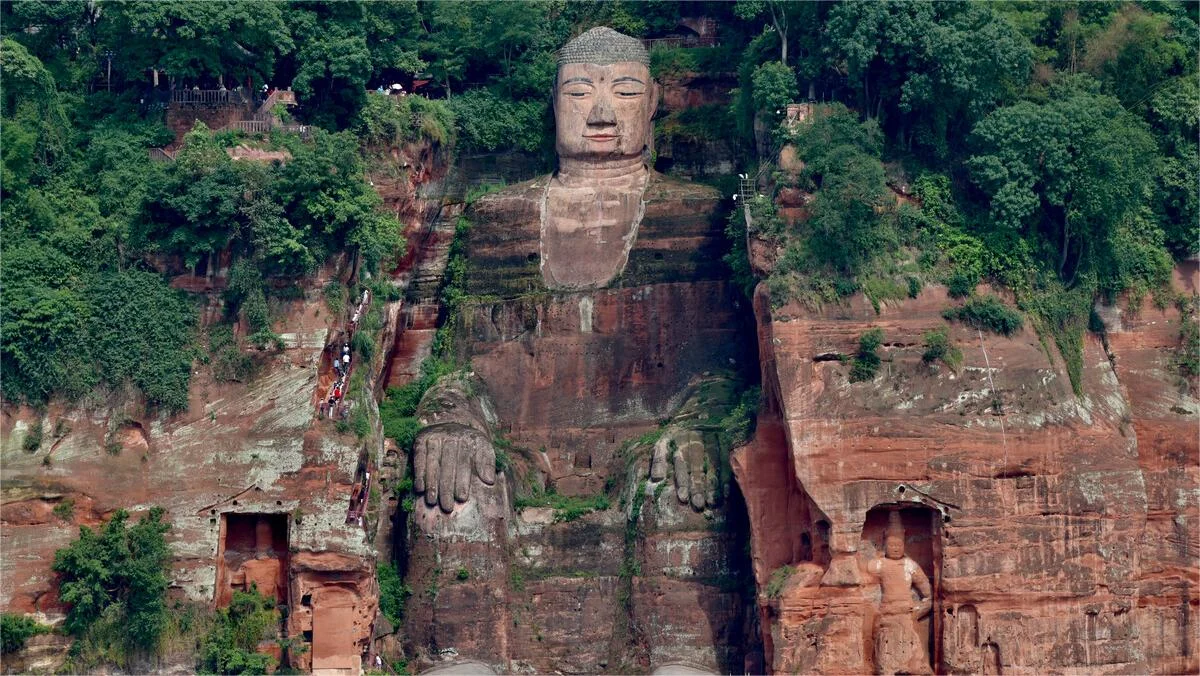The Leshan Giant Buddha is a magnificent stone statue located in the city of Leshan, in Sichuan Province, China. It is one of the most iconic and famous landmarks in the country, renowned for its colossal size, artistic craftsmanship, and historical significance. Here are some interesting facts about the Leshan Giant Buddha:
Enormous Size: The Leshan Giant Buddha is the largest stone-carved Buddha statue in the world. It stands at a staggering height of approximately 71 meters (233 feet) and is carved into the side of Lingyun Mountain, overlooking the confluence of three rivers: the Minjiang, Dadu, and Qingyi rivers.
Ancient Origins: Construction of the statue began during the Tang Dynasty in the year 713 AD, under the supervision of a Buddhist monk named Haitong. It took over 90 years to complete, and the statue was finally finished in 803 AD, during the Later Tang Dynasty.
Purpose and Symbolism: The Leshan Giant Buddha was created with the intention of calming the turbulent waters at the confluence of the rivers. According to Buddhist belief, the statue’s presence would protect sailors and prevent further shipwrecks in the area. The statue also symbolizes Haitong’s devotion to Buddhism and his desire to bring peace and harmony to the region.
Carving Technique: The statue was carved out of a giant red sandstone cliff using traditional Chinese sculpting techniques. The skilled artisans meticulously chiseled away the rock, shaping it into the figure of a seated Buddha. The entire process required remarkable precision and exceptional craftsmanship.
Unique Features: The Leshan Giant Buddha features many distinctive elements. The Buddha’s head alone measures about 14.7 meters (48 feet) in height, with its ears reaching a length of 7 meters (23 feet). The statue’s shoulders span 28 meters (92 feet), and its smallest toenail can accommodate seated people.
Intricate Details: Despite its colossal size, the Leshan Giant Buddha exhibits intricate and elaborate details. The statue’s coiled hair is made up of 1,021 individual buns, each skillfully carved. The eyebrows, eyes, and nose are also finely sculpted, reflecting the artistic prowess of the Tang Dynasty craftsmen.
Surrounding Scenery: The Leshan Giant Buddha is not only a remarkable sculpture but also located in a picturesque setting. Visitors can take in breathtaking views of the statue, as well as the surrounding lush vegetation, flowing rivers, and dramatic cliffs. The area around the statue has been developed into a park, offering various vantage points to admire the Buddha from different angles.
UNESCO World Heritage Site: The Leshan Giant Buddha was recognized as a UNESCO World Heritage Site in 1996. It is considered a significant cultural and historical treasure, representing the profound influence of Buddhism on Chinese art and architecture.
Preservation Efforts: Over the centuries, the statue has faced numerous challenges, including weathering, erosion, and damage from earthquakes. However, extensive preservation efforts have been undertaken to protect and maintain the Leshan Giant Buddha. These initiatives include reinforcing the statue, installing drainage systems, and implementing strict conservation measures.
Tourist Attraction: Today, the Leshan Giant Buddha attracts millions of visitors from around the world. Tourists can explore the surrounding area, climb the steps that lead to the Buddha’s feet, and even take a boat ride to appreciate the statue’s grandeur from the water.
The Leshan Giant Buddha stands as a testament to the rich cultural heritage of China, showcasing the skill and dedication of ancient craftsmen while offering a serene and awe-inspiring experience to all who visit.


